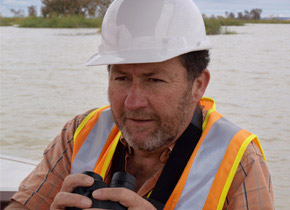Media releases
FedUni collaboration to understand country
Posted: Wednesday 1 November 2017
Federation University Australia is leading a collaborative project with the North Central Catchment Management Authority (CMA) and Barapa Barapa Traditional Owners to understand the ecological and cultural history of Gunbower Forest.
The pilot project, funded by the Murray-Darling Basin Authority (MDBA), The Living Murray program, is led by Professor Peter Gell, with Associate Professor Fred Cahir, and is in collaboration with researchers from the University of Melbourne.
The team has just returned from field days in the Gunbower Forest, which is part of the Gunbower- Koondrook-Perricoota Forest Liviong Murray icon site located on the mid Murray River. Together the forests form the second largest river red gum forest in Australia and a wetland of international significance under the Ramsar treaty.
The icon site also holds significant cultural value for the local Aboriginal communities with evidence of their rich history still seen across the landscape today.
"We are trying to bring together a common understanding of how the floodplain and its wetlands and connecting channels worked over time," Professor Gell said.
"The Barapa elders have many stories of how their ancestors used the resources of the floodplain and when these resources were available."
Indigenous studies historian Associate Professor Cahir spent time exchanging stories with Auntie Esther and Uncle Dixie while in the Forest.
"It is clear they themselves have clear recollections of these wetlands from their childhood and these are strengthened by memories of the stories handed down through generations," Associate Professor Cahir said.
"The Forest is rich in evidence of past campsites which are focussed around the wetlands so they must have been important foci for food collection and hunting."
Professor Gell said: "Our approach to history is to take sediment cores from the wetlands. These sediments record evidence of the state of the wetlands over time, from the time of the arrival of Europeans, and hopefully from before when Aboriginal custodians were the sole managers.
"We will be examining evidence of wetland change and our Melbourne University colleagues will examine fossil pollen and charcoal to see how the Forest was used over time," Professor Gell said.
"It is exciting to bring together the different lines of knowledge and to gradually assemble a broader understanding of the changes that have occurred to the forest to inform the challenges the North Central CMA are addressing in restoring the ecosystems of the floodplain."
| Contact | Matthew Freeman Senior Advisor, Media and Government Relations 03 5327 9510; 0408 519 674 m.freeman@federation.edu.au |
|---|